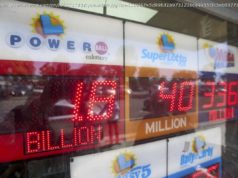The British street artist Banksy appeared to pull off one of his most spectacular pranks on Friday night, with a frame that shredded his “Girl With a Balloon” after it sold.
LONDON — The British street artist Banksy pulled off one of his most spectacular pranks on Friday night, when one of his trademark paintings appeared to self-destruct at Sotheby’s in London after selling for $1.4 million at auction.
The work, “Girl With a Balloon,” a 2006 spray paint on canvas, was the last lot of Sotheby’s “Frieze Week” evening contemporary art sale. It was hammered down by the auctioneer Oliver Barker for 1 million pounds, more than three times the estimate and a new auction high for a work solely by the artist, according to Sotheby’s.
“Then we heard an alarm go off,” Morgan Long, the head of art investment at the London-based advisory firm the Fine Art Group, who was sitting in the front row of the room, said in an interview on Saturday. “Everyone turned round, and the picture had slipped through its frame.”
The painting, mounted on a wall close to a row of Sotheby’s staff members, had been shredded by a remote-control mechanism on the back of the frame.
Ms. Long said that she next saw a “man with a detonator” being removed from the building by Sotheby’s security staff.
“We’ve been Banksy-ed,” Alex Branczik, Sotheby’s head of contemporary art in Europe, said at news conference afterward.
“I’ll be quite honest,” Mr. Branczik continued, “we have not experienced this situation the past, where a painting is spontaneously shredded upon achieving a record for the artist.”
Mr. Branczik added that he was “not in on the ruse.”
Sotheby’s has not named the client whose $1.4 million purchase has been destroyed. International auction houses do not divulge the identities of their buyers unless the buyer requests it.
But Sotheby’s said in a statement on Saturday: “The successful bidder was a private collector, bidding through a Sotheby’s staff member on the phone. We are currently in discussions about next steps.”
Joanna Brooks, the director of JBPR, who answers media enquiries on behalf of Banksy, declined to comment on whether the artist himself had been removed from the salesroom.
An image of the shredding, showing the shocked faces of those at the auction, appeared on Banksy’s Instagram account .
It had attracted 301,000 likes by Saturday afternoon.
But suspicious minds wondered whether Sotheby’s was completely taken by surprise. Anyone in the auction house who handled the painting would have surely noticed a mechanism on the back of the frame. Unusually, this relatively small Banksy had been hung on a wall, rather placed by porters on a podium for the moment of sale. And the artwork was also the last lot in the auction.
“If it had been offered earlier in the sale, it would have caused disruption and sellers would have complained about that,” Ms. Long said. “And Sotheby’s let a man with a bag with a detonator into the building. They must have known.”
For more than a decade, Banksy has created headlines with his daring, politically subversive artistic stunts. In 2005, the artist hung one of his “modified canvases,” showing a 19th-century beauty wearing a 20th-century gas mask, in the Metropolitan Museum of Art in New York for two hours.
The prank was one of several recorded in his best-selling book “Wall and Piece.” The following year, he left an inflatable doll dressed as a Guantánamo Bay prisoner in Disneyland.
The identity of the artist remains a secret. In 2008, the newspaper The Mail on Sunday suggested that Banksy was in fact Robin Gunningham, who was born in Bristol in the west of England and dropped out of private school at age 16 to dabble in street art, a theory for which academic researchers have found corroboration. Banksy and the Gunningham family in Bristol have denied the connection.
“We never comment on identity issues,” said Ms. Brooks, Banksy’s public relations manager.
As the artwork shredded itself, a seemingly unperturbed Mr. Barker, the auctioneer and Sotheby’s European chairman, said, “It’s a brilliant Banksy moment, this. You couldn’t make it up, could you?”
It was an unexpected finale — at least to those in the room — to a $90 million auction in which “Propped,” a monumental 1992 canvas of female nude by the Scottish painter Jenny Saville, sold for £9.5 million, or about $12.4 million, setting an auction high for an artwork by a living female artist.






